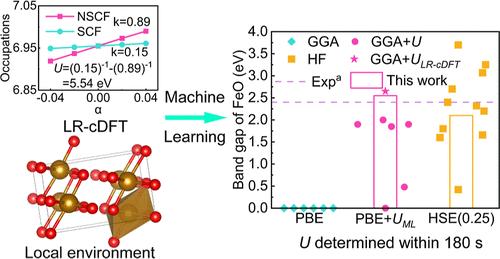当前位置:
X-MOL 学术
›
J. Chem. Theory Comput.
›
论文详情
Our official English website, www.x-mol.net, welcomes your
feedback! (Note: you will need to create a separate account there.)
Machine Learning Model for the Prediction of Hubbard U Parameters and Its Application to Fe–O Systems
Journal of Chemical Theory and Computation ( IF 5.7 ) Pub Date : 2024-11-07 , DOI: 10.1021/acs.jctc.4c01004 Wenming Xia, Guo Chen, Yuanqin Zhu, Zhufeng Hou, Taku Tsuchiya, Xianlong Wang
Journal of Chemical Theory and Computation ( IF 5.7 ) Pub Date : 2024-11-07 , DOI: 10.1021/acs.jctc.4c01004 Wenming Xia, Guo Chen, Yuanqin Zhu, Zhufeng Hou, Taku Tsuchiya, Xianlong Wang

|
Without incurring additional computational cost, the Hubbard model can prevalently address the electron self-interaction problems of the local or semilocal exchange–correlation functions within density functional theory. However, determining the value of the Hubbard parameter, U, promptly, efficiently, and accurately has been a long-standing challenge. Here, we develop a method for predicting the Hubbard U of iron oxides by establishing a potential relationship through machine learning fitting of structural fingerprints and the U evaluated by the linear response-constrained density functional theory method. This method performs well in calculating the properties of wüstite, hematite, and magnetite, aligning with experimental measurements or more costly hybrid functional results. Using this method, we redefine the convex hulls of the Fe–O system at 0, 50, and 100 GPa; the obtained results are in good agreement with experimental observations. We also provide insights into the debates surrounding the high-pressure phases of Fe2O3 and Fe3O4.
中文翻译:

用于预测 Hubbard U 参数的机器学习模型及其在 Fe-O 系统中的应用
在不产生额外计算成本的情况下,哈伯德模型可以普遍解决密度泛函论中局部或半局部交换-相关函数的电子自相互作用问题。然而,及时、高效、准确地确定哈伯德参数 U 的值一直是一项长期的挑战。在这里,我们开发了一种预测氧化铁哈伯德 U 的方法,方法是通过机器学习拟合结构指纹和线性响应约束密度泛函理论方法评估的 U 建立潜在关系。该方法在计算 wüstite、赤铁矿和磁铁矿的性质方面表现良好,与实验测量或更昂贵的混合功能结果一致。使用这种方法,我们重新定义了 Fe-O 系统在 0、50 和 100 GPa 处的凸包;获得的结果与实验观察结果非常吻合。我们还对围绕 Fe2O3 和 Fe3O4 的高压相的争论提供了见解。
更新日期:2024-11-09
中文翻译:

用于预测 Hubbard U 参数的机器学习模型及其在 Fe-O 系统中的应用
在不产生额外计算成本的情况下,哈伯德模型可以普遍解决密度泛函论中局部或半局部交换-相关函数的电子自相互作用问题。然而,及时、高效、准确地确定哈伯德参数 U 的值一直是一项长期的挑战。在这里,我们开发了一种预测氧化铁哈伯德 U 的方法,方法是通过机器学习拟合结构指纹和线性响应约束密度泛函理论方法评估的 U 建立潜在关系。该方法在计算 wüstite、赤铁矿和磁铁矿的性质方面表现良好,与实验测量或更昂贵的混合功能结果一致。使用这种方法,我们重新定义了 Fe-O 系统在 0、50 和 100 GPa 处的凸包;获得的结果与实验观察结果非常吻合。我们还对围绕 Fe2O3 和 Fe3O4 的高压相的争论提供了见解。


















































 京公网安备 11010802027423号
京公网安备 11010802027423号